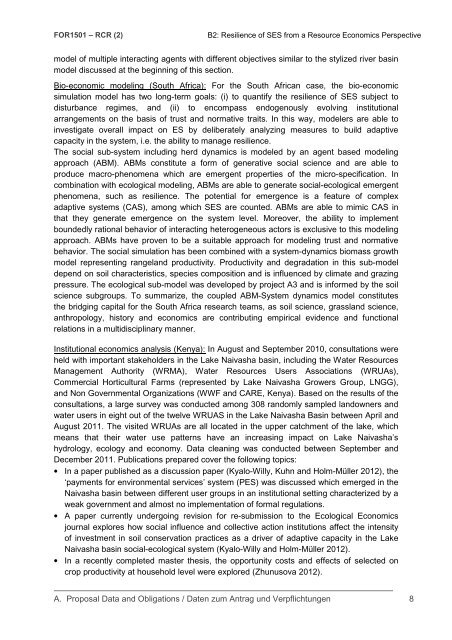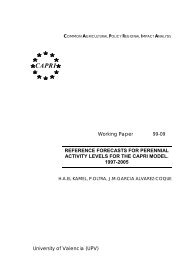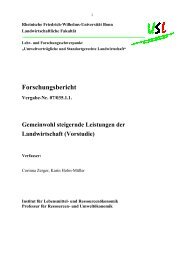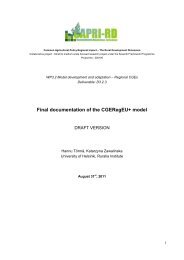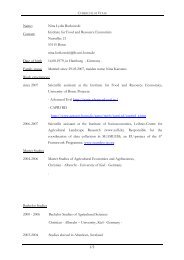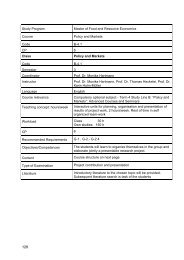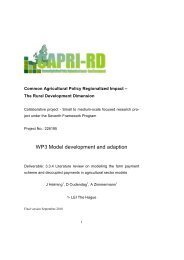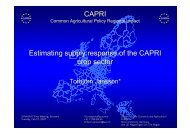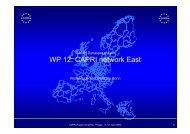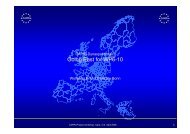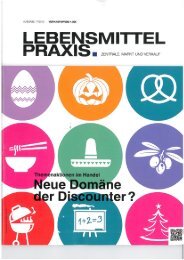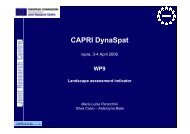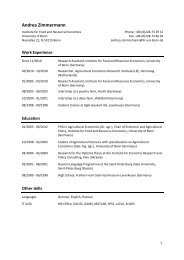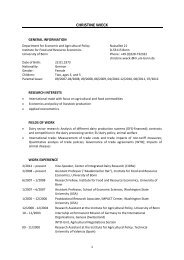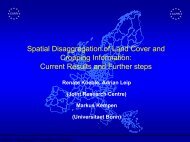Research proposal of sub-project B2 for second phase - Institut für ...
Research proposal of sub-project B2 for second phase - Institut für ...
Research proposal of sub-project B2 for second phase - Institut für ...
Create successful ePaper yourself
Turn your PDF publications into a flip-book with our unique Google optimized e-Paper software.
FOR1501 – RCR (2)<br />
<strong>B2</strong>: Resilience <strong>of</strong> SES from a Resource Economics Perspective<br />
model <strong>of</strong> multiple interacting agents with different objectives similar to the stylized river basin<br />
model discussed at the beginning <strong>of</strong> this section.<br />
Bio-economic modeling (South Africa): For the South African case, the bio-economic<br />
simulation model has two long-term goals: (i) to quantify the resilience <strong>of</strong> SES <strong>sub</strong>ject to<br />
disturbance regimes, and (ii) to encompass endogenously evolving institutional<br />
arrangements on the basis <strong>of</strong> trust and normative traits. In this way, modelers are able to<br />
investigate overall impact on ES by deliberately analyzing measures to build adaptive<br />
capacity in the system, i.e. the ability to manage resilience.<br />
The social <strong>sub</strong>-system including herd dynamics is modeled by an agent based modeling<br />
approach (ABM). ABMs constitute a <strong>for</strong>m <strong>of</strong> generative social science and are able to<br />
produce macro-phenomena which are emergent properties <strong>of</strong> the micro-specification. In<br />
combination with ecological modeling, ABMs are able to generate social-ecological emergent<br />
phenomena, such as resilience. The potential <strong>for</strong> emergence is a feature <strong>of</strong> complex<br />
adaptive systems (CAS), among which SES are counted. ABMs are able to mimic CAS in<br />
that they generate emergence on the system level. Moreover, the ability to implement<br />
boundedly rational behavior <strong>of</strong> interacting heterogeneous actors is exclusive to this modeling<br />
approach. ABMs have proven to be a suitable approach <strong>for</strong> modeling trust and normative<br />
behavior. The social simulation has been combined with a system-dynamics biomass growth<br />
model representing rangeland productivity. Productivity and degradation in this <strong>sub</strong>-model<br />
depend on soil characteristics, species composition and is influenced by climate and grazing<br />
pressure. The ecological <strong>sub</strong>-model was developed by <strong>project</strong> A3 and is in<strong>for</strong>med by the soil<br />
science <strong>sub</strong>groups. To summarize, the coupled ABM-System dynamics model constitutes<br />
the bridging capital <strong>for</strong> the South Africa research teams, as soil science, grassland science,<br />
anthropology, history and economics are contributing empirical evidence and functional<br />
relations in a multidisciplinary manner.<br />
<strong>Institut</strong>ional economics analysis (Kenya): In August and September 2010, consultations were<br />
held with important stakeholders in the Lake Naivasha basin, including the Water Resources<br />
Management Authority (WRMA), Water Resources Users Associations (WRUAs),<br />
Commercial Horticultural Farms (represented by Lake Naivasha Growers Group, LNGG),<br />
and Non Governmental Organizations (WWF and CARE, Kenya). Based on the results <strong>of</strong> the<br />
consultations, a large survey was conducted among 308 randomly sampled landowners and<br />
water users in eight out <strong>of</strong> the twelve WRUAS in the Lake Naivasha Basin between April and<br />
August 2011. The visited WRUAs are all located in the upper catchment <strong>of</strong> the lake, which<br />
means that their water use patterns have an increasing impact on Lake Naivasha’s<br />
hydrology, ecology and economy. Data cleaning was conducted between September and<br />
December 2011. Publications prepared cover the following topics:<br />
• In a paper published as a discussion paper (Kyalo-Willy, Kuhn and Holm-Müller 2012), the<br />
‘payments <strong>for</strong> environmental services’ system (PES) was discussed which emerged in the<br />
Naivasha basin between different user groups in an institutional setting characterized by a<br />
weak government and almost no implementation <strong>of</strong> <strong>for</strong>mal regulations.<br />
• A paper currently undergoing revision <strong>for</strong> re-<strong>sub</strong>mission to the Ecological Economics<br />
journal explores how social influence and collective action institutions affect the intensity<br />
<strong>of</strong> investment in soil conservation practices as a driver <strong>of</strong> adaptive capacity in the Lake<br />
Naivasha basin social-ecological system (Kyalo-Willy and Holm-Müller 2012).<br />
• In a recently completed master thesis, the opportunity costs and effects <strong>of</strong> selected on<br />
crop productivity at household level were explored (Zhunusova 2012).<br />
A. Proposal Data and Obligations / Daten zum Antrag und Verpflichtungen 8


